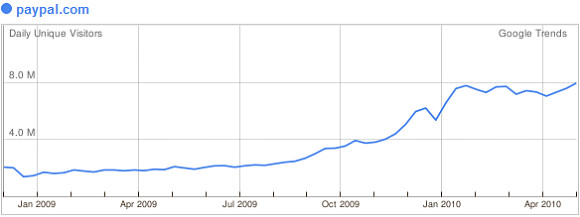 Paypal has been around since 1998 (eBay bought it in 2002), which is a small eternity in internet time. By now it’s easily the most established online payment solution, so it should be in a great position to benefit from our general tendency to increasingly buy and pay for things online.
Paypal has been around since 1998 (eBay bought it in 2002), which is a small eternity in internet time. By now it’s easily the most established online payment solution, so it should be in a great position to benefit from our general tendency to increasingly buy and pay for things online.
And something drastic happened about a year ago. Just look at how traffic to Paypal.com has been growing:

Something clearly happened during the second half of 2009 that made traffic to Paypal’s website more than triple over the course of just about 6-7 months. (Alexa also shows a big increase in traffic during 2009.)
Paypal has also been reporting significant increases in its earnings for some time now.
So what is behind this explosive growth? Here are some theories:
- Spending on virtual goods is growing, and Paypal is one of the most common means of payment.
- Paypal is widening its geographical reach, including an increased focus on Asia. But this can’t be the explanation. Any country you look at, the traffic curve looks similar to the above, so Paypal has done something that has had an effect across the board.
- Paypal released a popular mobile payment app for iPhone, Blackberry and Android. The iPhone app alone has more than a million downloads. This is bound to have had an impact, but how big?
- And here is, we suspect, the big one: In mid 2009, Paypal announced a flexible API that gives developers access to the Paypal platform, making it possible to use it with anything from applications to websites. They’re calling this platform Paypal X.
That last one matches the increase in traffic shown in the graph, timing-wise.
So, developer support is the key?
Paypal has really been focusing on enabling developers lately, which is a wise move. By making it easier for developers to use its platform, Paypal is boosting its own reach since it’s showing up in more and more places and contexts.
Just consider how third-party developer support helped the likes of Twitter and Facebook, so anything Paypal can do to reach out to developers is in all likelihood a very good thing. And those efforts are continuous. For example, Paypal recently announced a payment toolkit for Google’s App Engine.
More courting of developers coming up?
Being friendly with developers has obviously helped a number of services to new heights, and Paypal is now “rediscovering” this fact. However, they might soon be facing some stiff competition when it comes to vying for developers’ attention. A notable example is Mastercard, which less than a month ago announced plans to open up its platform to developers.
We hope this is a trend. More services offering powerful APIs to developers can only be a good thing, especially for useful things like handling payments.
(Or are we wrong? Is something completely different behind Paypal’s traffic and revenue increase? Let us know in the comments.)


























